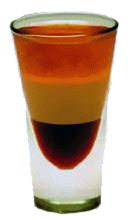Liqueur
Liqueur[edit | edit source]
Liqueur is a type of alcoholic beverage that is made by combining distilled spirits with flavorings such as fruits, herbs, spices, flowers, nuts, or cream. Liqueurs are typically sweetened and are often served as a digestif after a meal, used in cocktails, or enjoyed on their own.
History[edit | edit source]
Liqueurs have a long history, with origins tracing back to the Middle Ages when they were used for medicinal purposes. Monks and alchemists would create herbal concoctions believed to have healing properties. Over time, these mixtures evolved into the sweetened spirits we know today.
Production[edit | edit source]
The production of liqueurs involves several steps, including the maceration or infusion of flavoring agents in a base spirit, followed by sweetening and sometimes aging. The choice of ingredients and the method of production can greatly influence the flavor profile of the final product.
Types of Liqueurs[edit | edit source]
Liqueurs can be categorized based on their primary flavoring agents:
Fruit Liqueurs[edit | edit source]
Fruit liqueurs are made by infusing fruits in alcohol. Popular examples include Cointreau, Grand Marnier, and Limoncello.
Herbal Liqueurs[edit | edit source]
Herbal liqueurs are flavored with a variety of herbs and spices. Notable examples include Chartreuse, Bénédictine, and Jägermeister.
Cream Liqueurs[edit | edit source]
Cream liqueurs are made by blending cream with a base spirit and flavorings. Baileys Irish Cream is a well-known example.
Nut and Seed Liqueurs[edit | edit source]
These liqueurs are flavored with nuts or seeds, such as Amaretto and Frangelico.
Other Liqueurs[edit | edit source]
There are many other types of liqueurs that do not fit neatly into the above categories, such as Vana Tallinn and Licor Beirão.
Uses[edit | edit source]
Liqueurs are versatile and can be used in a variety of ways:
- Cocktails: Liqueurs are a common ingredient in many cocktails, adding flavor and sweetness. For example, the B-52 is a layered shot made with coffee liqueur, Irish cream, and orange liqueur.
- Culinary: Liqueurs can be used in cooking and baking to add flavor to dishes and desserts.
- Digestif: Many liqueurs are enjoyed on their own as a digestif after a meal.
Popular Brands[edit | edit source]
Some well-known liqueur brands include:
Related Pages[edit | edit source]
Search WikiMD
Ad.Tired of being Overweight? Try W8MD's NYC physician weight loss.
Semaglutide (Ozempic / Wegovy and Tirzepatide (Mounjaro / Zepbound) available. Call 718 946 5500.
Advertise on WikiMD
|
WikiMD's Wellness Encyclopedia |
| Let Food Be Thy Medicine Medicine Thy Food - Hippocrates |
Translate this page: - East Asian
中文,
日本,
한국어,
South Asian
हिन्दी,
தமிழ்,
తెలుగు,
Urdu,
ಕನ್ನಡ,
Southeast Asian
Indonesian,
Vietnamese,
Thai,
မြန်မာဘာသာ,
বাংলা
European
español,
Deutsch,
français,
Greek,
português do Brasil,
polski,
română,
русский,
Nederlands,
norsk,
svenska,
suomi,
Italian
Middle Eastern & African
عربى,
Turkish,
Persian,
Hebrew,
Afrikaans,
isiZulu,
Kiswahili,
Other
Bulgarian,
Hungarian,
Czech,
Swedish,
മലയാളം,
मराठी,
ਪੰਜਾਬੀ,
ગુજરાતી,
Portuguese,
Ukrainian
Medical Disclaimer: WikiMD is not a substitute for professional medical advice. The information on WikiMD is provided as an information resource only, may be incorrect, outdated or misleading, and is not to be used or relied on for any diagnostic or treatment purposes. Please consult your health care provider before making any healthcare decisions or for guidance about a specific medical condition. WikiMD expressly disclaims responsibility, and shall have no liability, for any damages, loss, injury, or liability whatsoever suffered as a result of your reliance on the information contained in this site. By visiting this site you agree to the foregoing terms and conditions, which may from time to time be changed or supplemented by WikiMD. If you do not agree to the foregoing terms and conditions, you should not enter or use this site. See full disclaimer.
Credits:Most images are courtesy of Wikimedia commons, and templates, categories Wikipedia, licensed under CC BY SA or similar.
Contributors: Prab R. Tumpati, MD





